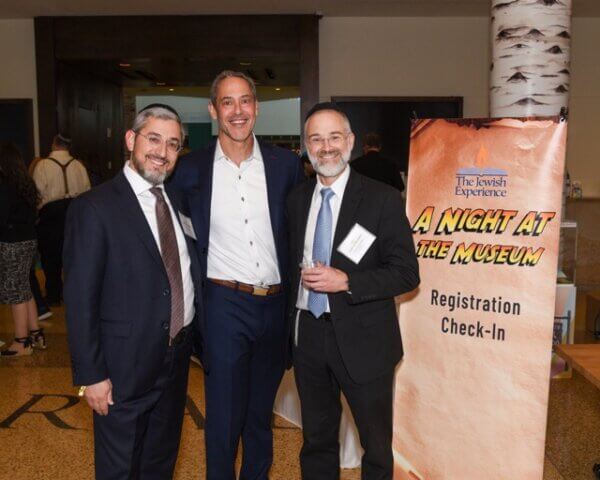VOLUME 71 NUMBER 9
This edition of Sparks of Torah is dedicated in the merit of a speedy recovery to Dov Shmuel ben Nechama Rivkah amongst all the ill members of the Jewish People.
The Long and Winding Road
by Rabbe Raphael Leban
It’s hard to write some light, witty remarks on the parsha during this bitterly tragic period in the Jewish calendar. These three weeks, known as bein hamitzarim, or ‘between the straits,’ are days of sadness and national mourning for a myriad of tragic events that happened to us on these days of the calendar. The fast of the 17th of Tammuz, the day that Moshe came down from Mt. Sinai and smashed the tablets, is the beginning. The fast of the 9th of Av, the day on which the Holy Temple in Jerusalem was destroyed not once but twice, is the culmination. In between is nothing but an ever-increasing sense of national despair. This year in particular we are acutely aggrieved, with the Jewish People under attack at home in Israel, and facing surging anti-Semitism abroad as well.
In Parshas Masei, which is always read during these three weeks, the Book of Bamidbar draws to a close. It’s really the culmination of the narrative events of the Torah. All that’s left is the Book of Devarim, which is comprised almost exclusively by Moshe’s remarks to the people in the last month of his life. It’s a farewell address before he leaves them to enter the Land if Israel.
What does the Torah bring the Book of Bamidbar to a close with? A detailed list of each leg of the journey that we made over the course of forty years, traveling out of Egypt and up to the border of the Promised Land. The name of the parsha, Masei, means ‘journeys.’ Every place we stopped, every place we camped is recorded.
I know other cultures and religions have special days and special periods of note in their calendars. I wonder, though, if they have days and weeks that are earmarked for national mourning and sadness. I’ve often been struck by the fact that as Jews we very purposefully celebrate days of joy, and just as purposely we observe days of sadness. There’s a whole spectrum of human emotion that we have to express, certain emotions for certain occasions. Life has joy in it, and it has sadness in it. Judaism is about feeling that total range of emotion deeply, both on a personal level and a national level.
Why do we make such a fuss about all the stops along the way on our trip through the desert? Some of them were magnificent, historic moments of awesome spiritual heights. For example, the first few steps out of Egypt or the short trip through the Sea. Others, however, were moments of weakness, failure and tragedy, like the place where the spies came back and discouraged the people from going to the Land of Israel. It was a big historic trip, but it wasn’t just a walk in the park.
G-d wants us to have big, open hearts. Hearts that can love, hearts that can feel joy, hearts that can feel sorrow. We strive to develop a yearning for His presence, and to miss Him when He’s distant. And we learn to express the range of these emotions from our human relationships, and from the lessons of our past.
We read about these journeys, and we learn that the life of the Jewish People is a long journey with many steps. We must remember and feel them all. We must open our hearts to feel all that they can. When it’s time to weep we weep, and when it’s time to laugh we laugh.
And may it be speedily in our days, that we will reach the end of our journeys, and we will truly laugh. Amen.
Inbound
By Rabbi Dovid Nussbaum
The Torah devotes a great deal of time and space mapping out the exact boundaries of Eretz Yisroel. Of course there are only certain mitzvos that can be performed within those confines and therefore it is necessary to possess a precise knowledge of the land. Nonetheless, it is somewhat puzzling that a geographic description, although it has halachic ramifications, should not have been just orally transmitted. Generally speaking we find that borders and geographic limitations play a major role in Judaism. For example, the Beis Hamikdash had a specific design and each area was assigned a clearly calculated zone. Was this done just for architectural beauty or was there a more sublime reason for this arrangement? Furthermore, just like at Mt. Sinai when the Torah was presented to the nation and there were designated positions for different segments of the nation, so too, in the Mishkan and subsequently in the Beis Hamikdash there were parts where only the priest could walk. Ostensibly, these sections of the Beis Hamikdash were viewed as more sacred and therefore the average Jew was barred from those parts. Does that mean the regular average Jew is not as holy as a priest?
Not only are we bound with geographical limits but time also hedges us in. Many mitzvos are locked into a time restriction and once we have passed that particular point in time, we can no longer perform the mitzvah, such as matzo on Pesach and a succah during Sukkos, and there are many other examples.
Furthermore, last Tuesday began a period know as the ‘Three Weeks” where many constraints are placed upon us. For example, we are not allowed cut our hair or shave or make weddings during this time of the year. Is there such a need for constraint? After all, in today’s society, the more free and unshackled you are the better? off you are! Everything is allowed and almost nothing is prohibited within the framework of today’s normal protocol. Which is superior, the old archaic Torah system or the new fangled do what you want approach?
Perhaps we should take a step back and try to discern the purpose of a person. Why are we created and given a life replete with difficulties and challenges that sometimes seem too overwhelming and stressful. The Talmud quotes the verse from Iyov that a person is created to toil and become excessively productive. In order to harness our tremendous potential and accomplish our goals and objectives in life, we need guidance and administrative direction. In other words, we need to be channeled correctly or we will not achieve that which we should and are capable of.
The Torah ‘maps’ out our life and its aim in so many ways in order that we will be able to look back at our time spent on this planet and marvel at that which we have surmounted. Others will review their lives and be disappointed that they did not grasp the importance of time and true utility of their energy to realize what they could have. However, the Torah is instructing us in so many ways to route ourselves so that when we come to the finish line we may be exhausted after a life that is chockfull of good deeds and tremendous gains but we will rejoice and celebrate the grandeur of our vista of a panorama of glistening sights and scenes of beauty and satisfaction.
A BYTE FOR SHABBOS
We see from the parsha that the stops along the way on our journey through the desert were not just places to pause and rest. They each taught us a profound lesson. In particular, we learned that sometimes we must distance ourselves from activities or places that may be detrimental to our spiritual and personal growth.
S’FAS EMES


